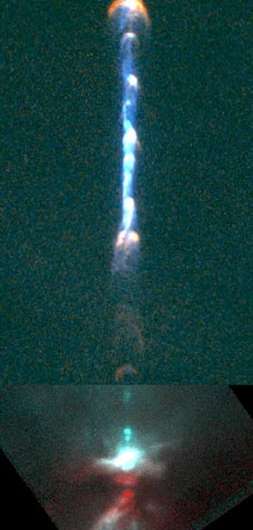The anatomy of a stellar outflow

(Phys.org) -- Astronomers used to think that star formation simply involved the gradual coalescence of material under the influence of gravity. No longer. Making a new star is a complex process, among other things assembling a circumstellar disk (possibly preplanetary in nature) and at the same time ejecting material as bipolar jets perpendicular to those disks. These outflows help the young star balance its growth as new material accretes, but at the same time they disrupt the environment. Although jets from young stars have been known for over twenty years, their influences on the environment have remained uncertain, in part because the dusty natal clouds in which stars form obscure optical light.
SAO astronomers Achim Tappe, Jan Forbrich, and Charlie Lada, with two colleagues, used the spectrometer on the Spitzer Space Telescope to probe one relatively nearby, young stellar outflow. It had already been known that this fast-moving jet, as it plowed into the medium, shocked the gas; the process is much the same as when a jet plane moves faster than the speed of sound and creates a shock wave. But for young stellar outflow, the particulars were mostly mysterious. The scientists discovered in the infrared spectra a rich trove of bright emission features from at least seven different molecules excited by the shock - molecular hydrogen, water, carbon dioxide, carbon monoxide, OH, HD, and one ionized species of HCO. Numerous atomic lines were also observed.
The astronomers concluded that the shock has distinctive regions along its length as it plows through the natal cloud at velocities of about 40 kilometers per second. At the very tip, where the jet suddenly encounters ambient gas and slows down, there is ionized material and strong molecular hydrogen emission; closer to the star the gas temperatures and densities vary in systematic ways as previously excited gas begins to cool off. Bright knots are seen all along the jet's path, either the result of ejected hot clumps or previously existing clumps that were shocked when the jet passed. The new paper is among the first to discover and analyze the complex infrared radiation from shocks around new-born stars, and it helps open the door to new methods of probing the environment of star formation.
Provided by Harvard-Smithsonian Center for Astrophysics




















